Simple Sitting Adjustments for Less Back Pain

Overview
Americans spend a lot of time sitting – working on computers, watching TV, commuting to work, and more. Americans also spend a lot of time and money at the doctor’s office due to back pain – about $50 billion each year. According to the American Chiropractors Association, back pain is the second most common reason for visits to the doctor's office after upper-respiratory infections. Is there a connection between so much sitting and back pain? Possibly. Chiropractor John J. Triano says that sitting, because of its static nature, places a high amount of stress on your back muscles and spinal discs. However, making a few adjustments to your sitting habits can ease this stress and help alleviate back pain.
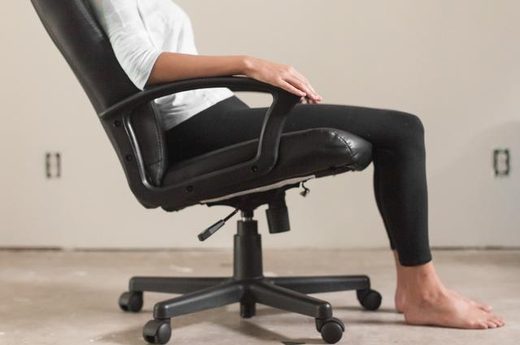
1.Don't Sit Up Straight
Your mom may not have given you the best advice when she reprimanded you for leaning back in your chair at mealtimes. Study findings released in November 2006 explain that sitting in an upright position may put undue stress on your back, leading to back pain. Instead, researchers of the study that was conducted at Woodend Hospital in Aberdeen, Scotland, suggest that leaning back enough so that your thighs are at a 135-degree angle with your torso is an optimal seated posture for preventing back pain. So go ahead, sit back, relax and read on for more pain-relieving posture tips.
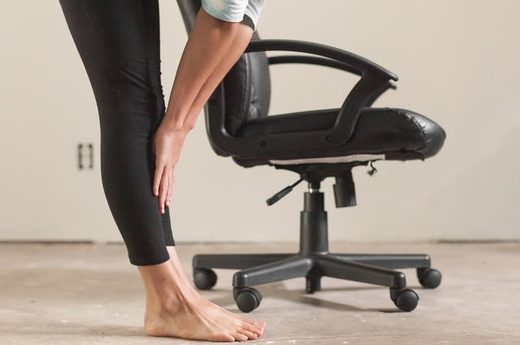
2.Don't Sit Still
While fidgeting in your chair may not be conducive to productivity, sitting in the same position for long periods of time is not healthy for your back, says the Canadian Centre for Occupational Health and Safety. According to their website, long periods of sitting increases the risk of muscle pulls, strains and cramps; slows blood supply to the neck and back muscles, causing fatigue; puts undue amounts of pressure on the spine; and causes compression of the spinal discs. If you don't have the luxury of taking frequent breaks to stand up and move around, the center recommends sitting in a range of positions -- any position that doesn't hinder proper breathing or circulation or impede functions of the muscles or internal organs is a healthy sitting position.
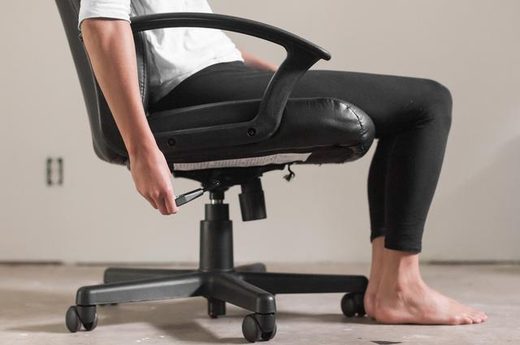
3.Choose the Right Chair
The right office chair can help you avoid back pain or prevent it from worsening, writes Rodney K. Lefler, D.C. on the Spine-Health website. Leflerrecommends choosing an ergonomic office chair. According to Lefler, an ergonomic office chair supports the lower back and promotes good posture, giving you one less thing to think about while you're working. Look for chairs with lumbar adjustment. The best lumbar setting will mimic and enforce the natural curve of your spine, preventing you from slouching, writes Lefler. He says the backrest should also be able to be adjusted forward and backward to support your back in different working positions. How does your chair measure up? Maybe it's time to have a little talk with your boss about your chair!
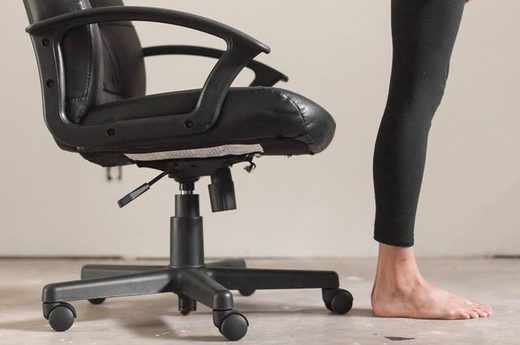
4.Sit at the Right Height
No matter what position you sit in, it's essential to adjust your chair to the right height to prevent back pain. According to the Canadian Centre for Occupational Health and Safety, your chair should be adjusted according to your height to promote proper seated posture. To do this, stand in front of your chair and adjust the seat of the chair so that its highest point hits just below your kneecap. When sitting on the chair, your feet should be flat on the floor and your hips should be parallel to or just slightly higher than your knees.
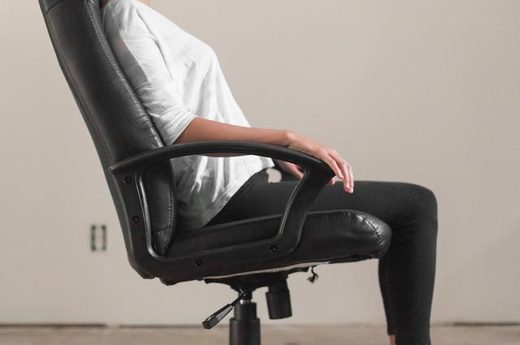
5.Don't Slouch
Although forward sitting is sometimes necessary, depending upon the task you are engaged in, it's not a good idea to let your shoulders roll forward or to let your back hunch into a slouched position. Vivian Ledesma, D.C., says that the natural curvature of your spine, like a bridge's arch, is what gives it strength, leverage and flexibility. "When you slouch and let your hips fall back, your low back flattens out and you no longer have the curve in place." Ledesma says that this reduces shock absorption, throws the discs out of alignment, reduces circulation and spinal fluid and puts more tension on your spinal cord. "When you slump, your neck shifts forward, which also adds tension to your musculature and your spinal cord," Ledesma notes.
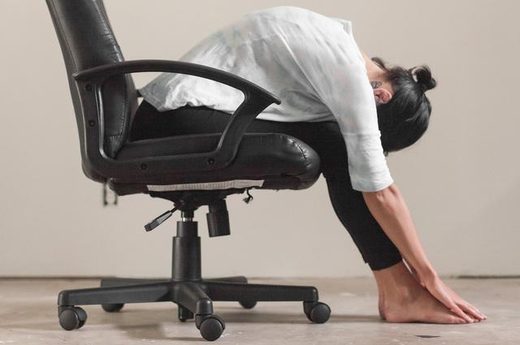
6.Do Simple Stretches
Performing a few seated stretching sessions throughout your day encourages you to shift your position frequently to avoid stiffness and potential injury from sitting in one posture for too long, and it helps lengthen and relax your back muscles. Easy seated stretches include reaching your arms overhead; rolling your chair away from your desk and folding forward at your waist to touch your toes; and rotating your torso to look over your left and right shoulders. Hold each stretch for about 10-to-15 seconds without bouncing. And then get back to work.
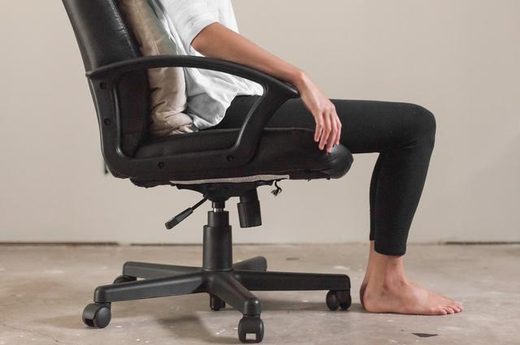
7.Use Props to Achieve the Right Posture
You don't always get to choose your work chair, and you might sometimes find yourself in an ill-fitting workspace, especially if you travel frequently and have to work remotely. Chiropractor John Schubbe recommends adapting your workspace to your body as much as possible to ensure proper posture. For example, if you are sitting in a chair that is too high for you that can't be adjusted, Schubbe recommends using a foot stool, or another suitable object -- a short box, perhaps -- to elevate your feet until your knees are at the ideal 90-degree angle. Similarly, if the back of your chair pushes you too far forward, you might try using a pillow at the small of your back to increase the angle between your thighs and torso. The store called Relax the Back has all sorts of chair and lumbar pillows especially for providing correct support. There is also a simple product called Backjoy Posture+ which you can put on your chair to tilt your pelvis and lower back into a more supported seated position in your chair.
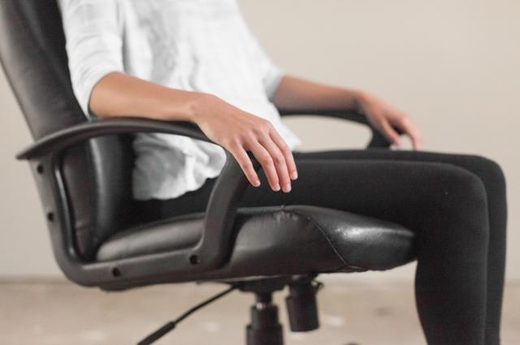
8.Use Your Armrests
Whether you love 'em or hate 'em, chair armrests can help prevent back pain. Dr. Kelly Blundy of The Spine and Health Center of Montvale, New Jersey, says that armrests should be positioned in such a way that the arms are just slightly lifted at the shoulders, which takes some of the strain off your neck and shoulders. Using the armrests may also make you less likely to slouch, says Kelly.

9.Keep Your Hips Level
At the office, you'll see coworkers sitting in all sorts of positions, but Vivian Ledesma, D.C., says whichever position you choose, keep your hips level. "When you put more weight on one hip, you bend the spine, putting tension on the spinal cord, causing the shoulder to over-round and increasing tension in your upper back," explains Ledesma, who is the owner and director of Alliance Healing Arts in Seattle Washington. "Sitting flat, making sure that both sit bones are equal is really important," she notes.
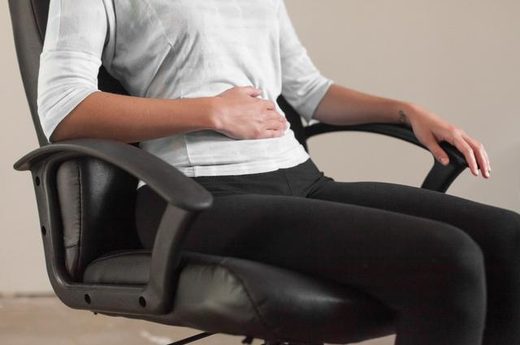
10.Activate Your Muscles to Support Your Spine
Most people don't think about using their muscles while sitting, a mostly passive activity, but fitness expert John Carrico says activating key muscles throughout your day can help prevent back pain. Your pelvic floor and abdominal muscles help to support your spine, which can take some of the pressure off your back. Carrico, who co-owns Excellence Health and Fitness in Seattle, Washington, says you don't have to engage those muscles all day long, but he recommends reminding yourself to activate them every hour or so.
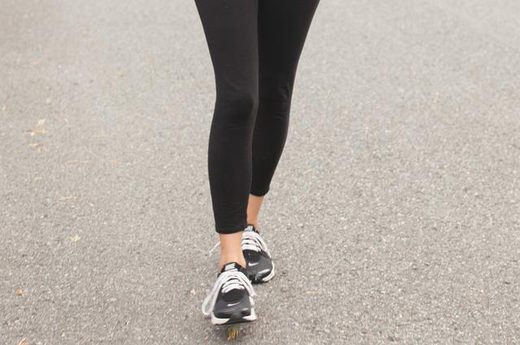
11.When You're Not Sitting, Get Active
All of these tips for sitting pretty won't do you any good if you don't take advantage of the time you're not sitting to be active, particularly doing activities that help strengthen the muscles that support your spine. Get up from your desk every once in a while and take a brisk walk; when you're finished with your work day, don't go home and sit on the couch -- take a yoga class or go to the gym. Vivian Ledesma, D.C., recommends forms of exercise that involve lengthening -- "length and strength without a lot of compression," she says. Pilates is a good example. Most important, she says, is maintaining good form and proper alignment, no matter what type of exercise you choose.
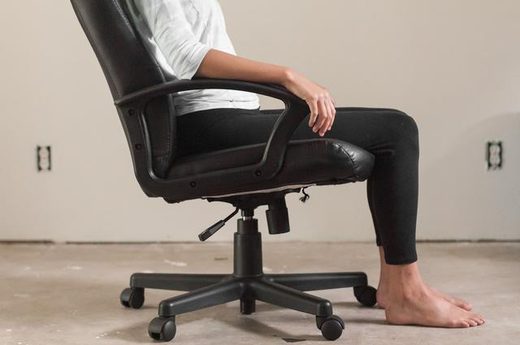
12.Make Small Changes for Better Spine Health
By this point, you may be thinking that it's nearly impossible to employ all of these posture adjustments and still focus on getting your work done. So, focus on making one change at a time. Ensure that your chair is at the proper height, and then sit and assess your normal seated posture. If you tend to slump, concentrate on maintaining that slight curve in your lower back. Set a time to remind yourself to change positions every so often, take a break and do some seated stretches or go for a walk.

What Do YOU Think?
Do you suffer from back pain? How bad is it and how often does it occur? Do you think these tips can help you? Did you find any of them surprising? Do you have a other techniques or tips for sitting properly? Leave a comment below and share your experience and tips to help others prevent back pain.
Note – This information has been taken from different internet sources.
- Choosing a selection results in a full page refresh.

7 comments
Rachel Grice
Great suggestions. I also think sitting on a stability ball does wonders for strengthening the back/core and preventing pain.
Jared White
Don’t forget the other alternative: sitting less! I use a stand-up desk and it’s amazing! Sitting is connected to diabetes and increased risk of early mortality …even if you exercise every day!
Daniel
good.i’m going to try sitting very well
Emily Arnold
As I was reading about siting, I actually sat up straighter in my chair!
Kalyani Sana
fellows, please take a look to alleviate your back pain.